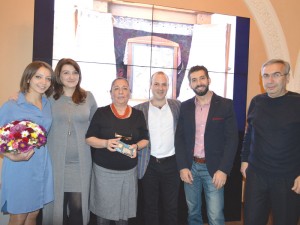
Eliazyan, Artavazd Ayvazyan, Arthur Petrosyan, and
Gagik Ginosyan, from the village of Tsughrut.
Photo: ASP Archive
Staff Report
The more than one thousand year old Gospel of Tsughrut (Ծուղրութի Աւետարան-Hovhannes Avetaran) is a rare example of Armenian medieval art in terms of its iconography and simplicity of miniature expression, dating from 974 AD. Many times referred to as the “Guardian of Tsughrut,” the Gospel has been carefully preserved and protected since 1830 by the Saponjyan family as the holy relic of the village.
The American Research Institute of the South Caucasus (ARISC) held a public presentation by ARISC Fellow Arusyak Baldryan on October 25, 2016 at the Matenadaran in Yerevan, Armenia, to give an update about the grant, making it possible to implement the conservation and restoration of the manuscript in the village of Tsughrut.
This work ensured the continued preservation of the unique manuscript.
Prof. Der Mugrdechian, Berberian Coordinator of Armenian Studies Program at California State University, Fresno and Baldryan, an MA student of UNESCO World Heritage Studies at Brandenburg Technical University of Cottbus Senftenberg in Germany successfully applied and received a grant for the restoration work.
The conservation of the manuscript has been implemented by senior conservators of the Matenadaran, Artavazd Ayvazyan and Arthur Petrosyan, biologist Lusine Markaryan and with the supervision of Dr. Gayane Eliazyan, Head of the Restoration Department of the Matenadaran.
The conservation work was preceded by a biological analysis of the manuscript for the purpose of identification of fungi, other biological bodies, and to evaluate the overall state of the manuscript.
The project has been significant and the Acting Director of the Matenadaran Mr. Vahan Ter Ghevondyan and Fr. Zakaria Bakhumyan, a representative from Holy Etchmiadzin stated, “with this project the stereotypes have been broken. Now we know that it is also possible to take care of the innumerous Armenian manuscripts preserved in family houses, locally.”
This was the first time that the Matenadaran Conservation Department was able to implement conservation work outside of its laboratory and has given them experience for future projects.
There are a large number of important and valuable manuscripts that are badly in need of recovery and are preserved by families in remote villages.
The next step is to search for new funds for a long-term project to continue the work started with the generous support of ARISC.
 Hye Sharzhoom Armenian Action
Hye Sharzhoom Armenian Action